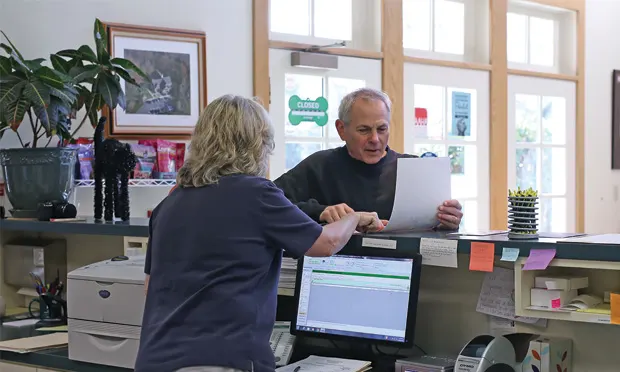Tools for Talking to Your Clients About Money
Lisa J. Hunter, MSW, Colorado State University
Jane R. Shaw, DVM, PhD, Colorado State University

Mrs. Baker runs into the clinic with Beau, her beloved family cat, who has been hit by a car. From your triage examination, you determine that Beau’s leg is broken and he is in shock. Your team begins stabilization. You present Mrs. Baker with an initial treatment plan and the cost estimate. Her face turns pale and she starts to cry. Carefully working through this discussion is integral to caring for Beau and sustaining your relationship with the Baker family.
Discussing finances with clients is crucial, yet research indicates that these conversations are not commonplace.1 Stress, privacy, and strong emotional ties may heighten emotions on both sides. The well-being of animal companions that depend on their caregivers as their advocates is often at stake. That pressure can weigh heavily on caregivers who wish they could afford the full treatment plan and veterinarians who feel guilty that they cannot do more for their patient and client.
Communication tools can turn a stressful financial discussion into a successful action plan. Whether you are presenting an estimate, delivering emergency treatment costs, or working with a client who has limited funds, start with a strong foundation of trust.
Build a Foundation
Using appropriate nonverbal behavior develops rapport and sets the tone for success.2 A private room away from the waiting area provides a safe place for clients. Sitting down slows the heart rate and promotes relaxation, while speaking with a softened tone, lowered volume, and slower pace is calming, allows clients to focus on the conversation, and minimizes distractions. Setting this stage creates an opening to discuss the costs of care upfront and to set clear expectations.2
Lend a Hand
Acknowledge the client’s difficulties, strain, and financial stressors [empathy] to open the discussion and form a nonjudgmental atmosphere. Offering partnership in seeking solutions through the use of “we” statements or sentences that use inclusive language (eg, let’s, us, together) builds a veterinarian–client team. Asking permission before stating opinions or offering suggestions and support puts the ball in the client’s court, empowering him or her to work toward a resolution.
Veterinary care is expensive [empathy]. This emergency is particularly difficult because it was an unexpected expense [empathy].
Let’s work together to seek a solution that will work within your family’s budget [partnership].
I’m wondering if I could share a few financial resources with you [ask permission]?
Financial Assistance Options
A handout that provides financial assistance programs empowers clients to seek alternatives in an overwhelming situation. Include information on the following:
Breed-specific funds
CareCredit
Good Samaritan funds
Payment plans
RedRover Relief
Wellness plans
Pet insurance
Lay It All Out
Presenting small amounts of information [chunk] and then pausing [check] will allow the client to absorb information and formulate relevant questions, and will move the conversation toward solutions.2
The emergency fee for our services is $90. This is in addition to the cost of treating Beau for his injuries, which I anticipate will be $750 [pause].
I know that you did not plan for this [empathy]. Tell me how you are doing so far [check].
Let’s sit down and go over the treatment plan together [signpost] so we can make sure we are on the same page for Beau’s care [partnership].
The plan includes x-rays to identify how Beau’s bone is broken and determine the best way to repair his fracture. The cost of the x-ray is $150. What questions do you have [check]?
Treating Beau’s fracture with the best option will ensure that we get him back on his feet as soon as possible. How does that sound to you [check]?
When discussing finances, provide specific treatment options and their estimated costs. For each diagnostic test and procedure, include the rationale (ie, why it is valuable) and the benefit to the patient (ie, how it will promote the patient’s well-being).3
Include a low-end estimate contrasted with a high-end to provide valuable information for clients when making treatment decisions. Explain that an estimate is not an exact science and you will provide regular updates. It is better to give too much information at the beginning than to scramble and defend treatment decisions after-the-fact. Setting expectations ahead of time helps clients prepare and manage their budget.
Negotiate
Negotiating a mutually accepted treatment plan with clients encourages their participation while increasing their buy-in. Seek their perspectives, beliefs, concerns, questions, and feelings [elicit perspective] with open-ended questions (eg, tell me, how, what, describe for me). The patient is part of the client’s life, often a family member. Knowing how that family works, its challenges, and the assets family members bring to the table ensures a plan that the client will agree on, follow, and pay for.
Will you tell me more about your financial concerns with Beau’s treatment [open-ended question]?
So I can best care for you and Beau [partnership], would you share with me what you are comfortable spending for Beau’s treatment [open-ended question]?
We will find a way to care for Beau that is mindful of your financial limitations [partnership].
Helping clients decide on a financial limit provides a point of negotiation for the best treatment options within their budget.
Determine how the client wants to proceed. Compromise is the core of these discussions, because you are striving to balance staying within the client’s budget and providing the best care for the patient. Helping clients decide on a financial limit provides a point of negotiation for the best treatment options within their budget.
Conclusion
Productive client conversations about finances lead to enhanced compliance with the veterinarian’s recommendations and effective treatment outcomes. Creating a safe and supportive setting, empathizing with the client’s predicament, and educating the client about the rationale for the treatment and its associated costs are key to navigating these difficult discussions.
These skills set clear expectations, maintain client relationships, promote patient care, and result in a high-performing practice.